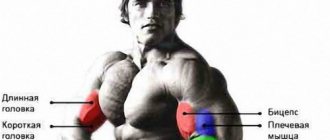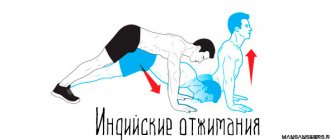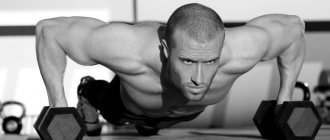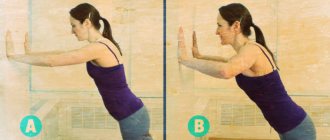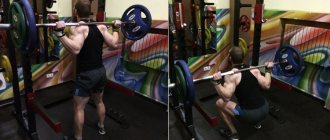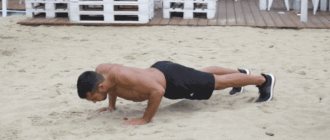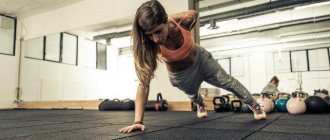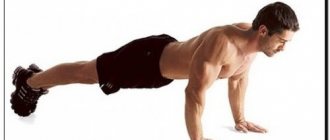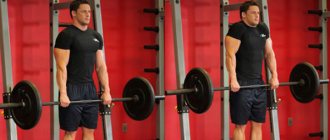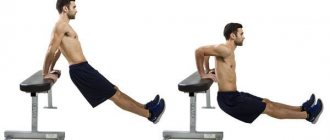Pain in the lower back and wrists when doing push-ups
It happens that novice athletes who do strength exercises at home are faced with pain in the lower back or wrists while doing push-ups. Let's look at the causes of pain and how to fix it. IF YOUR LOVER (BACK) HURTS WHEN DOING PUSH-UPS FROM THE FLOOR Pain in the lower back while doing push-ups from the floor can occur for several reasons. The first, most common reason is weak abdominal muscles!
The fact is that the upper and lower body are powerfully connected precisely by the muscles that form the abdominal wall. It turns out that the lumbar spine, which also connects the top and bottom of the body, is strengthened by these muscles, plus, of course, its own intervertebral muscles and ligaments.
When you take a push-up position on the floor, your body forms a bridge between your feet and arms, while it is the abdominal muscles that powerfully anchor the middle of your torso and keep your body straight and horizontal. If the abdominal muscles are weak, then poor stabilization occurs in the lower back and a bend occurs, so the load falls on the intervertebral ligaments and joints, which can lead to pain. Hence the important rule: Do you want to perform push-ups well and confidently? Then be sure to develop powerful abdominal muscles! You should start with the simplest exercises to train your abdominal muscles and gradually increase their complexity. Well, it also takes time and regular practice for the muscles and ligaments of the spine to also strengthen and become more powerful. The right program for developing strong abdominal muscles: Training program for men Training program for women
The second cause of lower back pain is injuries and diseases of the spine. These include: scoliosis (curvature of the spine), sprains or injuries of ligaments, as well as hernias or protrusions of intervertebral discs. In these cases, it is of course advisable to consult a doctor to clarify the situation. If the cause of pain is associated with an injury or disease, then the general instructions will be as follows: 1. Eliminate exercises that cause pain and select available exercises to train the necessary muscles. 2. It’s worth starting with lighter options or simpler exercises. For example, there are lighter versions of push-ups and exercises with dumbbells. 3. Be sure to perform corrective, therapeutic, and strengthening back exercises that are appropriate for your situation.
An important sports rule for everyone: Before doing push-ups, you should definitely do warm-up exercises for the whole body, including the back. Before power loads, ligaments, joints and muscles should be well warmed up, this will save you from injuries and other problems.
WHY WHEN DOING PUSH-UPS FROM THE FLOOR CAN YOUR WRISTS HURT The wrist is a small part of the hand that has a complex anatomical structure. In this small area there are eight separate bones that are connected to each other by many small joints and ligaments. This is a very complex and important unit that ensures high mobility of the hand and fingers... In untrained people, the joints, bones and ligaments in this place are still weak, so they can react sharply to unusual, increased loads. During push-ups, when you press into the floor, more force is passed through the wrists and increased compression occurs in these areas, which can cause pain. This is a temporary phenomenon; with proper training, your wrists will become very strong and there will be no pain. Of course, the cause may also be injuries or diseases of the wrist, former fractures, but this is a separate story that requires the attention of a doctor...
WHAT TO DO IF YOUR WRISTS HURT WHEN DOING Push-ups The first thing is to thoroughly warm up and warm up your joints! Before starting strength exercises, be sure to do rotational movements 10-20 times in each direction and repeat 3-4 times so that the ligaments warm up very well. Then do flexibility exercises - flexion and extension of the hand with the help of the other hand, just do it very carefully... Play sports correctly, do not forget to warm up your whole body.
Secondly, start loading and strengthening your joints gradually! Gradual progression of loads is one of the most important rules in sports. Never try to break your ligaments and joints; if pain occurs, then you are forcing the process too much. To begin with, do push-ups on a soft mat on your palms, then on your fists, then try on the floor on your palms, and as your ligaments strengthen, you will be able to perform this exercise in any conditions, even standing on your fists on rocks... but you need to get to this gradually.
Third, strength exercises to strengthen the muscles of the forearm and hand will additionally help. Wrist curls with dumbbells or a barbell, holding heavy objects with your fingers, various expanders, hanging on the bar - there are many useful exercises for strengthening the ligaments and muscles in this area. See section "Exercises"
Do you want to exercise correctly, learn how to do push-ups at least a hundred times and build sculpted muscles? PROGRAM OF PUSH-UPS FROM THE FLOOR FOR THE NUMBER OF “MARATHON PUSH-UPS”
All rights to materials published on this site are reserved. No part of these articles may be reproduced without the permission of the author and copyright holder
Want to know what's new on the Athletic Blog? SUBSCRIBE – and live with sports!
source
Is it possible to do push-ups with spinal osteochondrosis?
The human spine performs a number of important functions. However, the modern rhythm of life negatively affects its condition and various diseases of the cartilage discs arise. They wear out, become fragile, sag, causing pain and discomfort.
One of the common diseases of the spine is osteochondrosis. It is a series of dystrophic disorders that occur in articular cartilage. As a rule, it affects the intervertebral discs and is expressed in thinning of the disc thickness.
In turn, this leads to nerve pinching and pain. Often the disease affects those parts of the spine that bear the maximum load.
Alas, cartilage tissue does not regenerate, so the only solution to the problem is to strengthen the back muscles. This will relieve stress from the spine and eliminate pain. Therefore, for osteochondrosis, push-ups, pull-ups and other physical exercises that do not load the spine are useful.
Many people ask the question, is it possible to do push-ups with osteochondrosis? It’s not just possible, but necessary. But push-ups alone will not be enough. It is advisable to train in a complex manner to get maximum results.
In this material we will analyze how push-ups help against osteochondrosis of various parts of the spine. What are the nuances and features?
Lactic acid after workout
Lactic acid after training is the main cause of muscle soreness. Our body synthesizes ATP (adesino triphosphate) through the breakdown of carbohydrates, the energy that is formed is used for high and medium intensity training.
As a result of this, fast and slow glycolysis is triggered; in the process of fast glycolysis, pyruvate (a salt of pyruvic acid) is formed, which is further formed into lactic acid.
In the process of accumulation of lactic acid, the acidity of cells increases, which slows down rapid glycolysis and the body
automatically produces less energy to lift weights and fatigue sets in.
Also, when muscle failure occurs, you feel a burning sensation in the muscles, this is due to the fact that lactic acid strongly irritates the receptors.
Lactic acid after training is our body’s self-defense from enormous overloads that can cause irreparable harm.
But there is one caveat: the concentration of lactic acid decreases after exercising the muscles for several hours, so why do the muscles hurt?
Scientists are not yet completely sure, but with a high degree of probability this is due to swelling of muscle tissue, due to the sudden arrival of leukocytes to heal micro-tears in muscles, so muscle pain after training is a normal, natural process.
How to do push-ups with osteochondrosis?
There is no specific push-up technique for this disease. The main thing is that all movements are measured and neat. It is important to understand that you can start exercising only when the pain subsides.
Only then can you begin to tone your back muscles in order to forget about pain. If you feel pain or discomfort when doing push-ups, it is better to avoid them. Alternatively, try starting with lighter variations.
If the muscles are not in good shape, then it is better to start push-ups from the wall, then move on to some kind of elevation. Next from the knees and only then from the floor. This will strengthen your back and abdominal muscles, arms and core, and prepare your entire body for the load. Over time, you can begin to add more complicated push-up variations.
You don't let your muscles relax
Tension in the muscles occurs when you “clog” them with high loads or a large amount of work. While this leads to muscle development, it can also lead to sharp pain if you don't relax properly. Have you ever seen a guy at the gym who bench presses for an hour and then walks around the bench with his shoulders pushed forward? This is because his pectoral muscles are overextended. The same thing can happen to you during push-ups.
How to fix it
Between sets, try doing a bridge on an exercise ball. This will stretch your core, chest, shoulders, and even your latissimus dorsi. Here's how to do it correctly: lower your head and the back of your head onto the ball and extend your arms so that they are perpendicular to your body. Lower your shoulders towards the floor. Stay in this position for 10 breaths.
Tips and tricks
Push-ups for osteochondrosis are a good and practical exercise. However, you won't be able to go far with push-ups alone. Prevention and treatment of the disease requires an integrated approach and a number of exercises that will help you recover.
For example, squats and pull-ups. By adding them to your training program, you can strengthen all parts of the spine. But regular exercise in the gym will help you achieve the most positive effect.
source
Therapeutic push-ups. Execution technique. Benefits for the spine and blood vessels
He fell and did push-ups. Everyone knows this exercise, but it is not done often and not always correctly. Maybe you lack motivation? Everything is too simple, like an army. However, push-ups are, in fact, one of the best, universal exercises that simultaneously develops several muscle groups, helps to form a strong muscle corset, serves as a prevention of spinal diseases, strengthens blood vessels and supports the heart.
First, let’s dispel one stereotype that this exercise is only for young and healthy people. In fact, you can start doing push-ups with support - from a table, chair, even from a wall, if the body is weakened, thereby “selecting” the load according to your capabilities. Or you can do push-ups from the floor, but from your knees. And as the pectoral muscles and arms strengthen, switch to the classic version.
Push-ups, despite their apparent simplicity, when performed regularly, bring tangible health benefits.
Benefits for the spine
Push-ups strengthen not only the pectoral muscles, but also the abdominal muscles, arms (deltoid muscles of the shoulder, triceps and biceps), thereby developing a muscle corset that supports and nourishes the intervertebral discs. Therefore, push-ups in the future protect us from the risk of protrusions and redness, back and neck pain.
Improved posture
For good posture, exercises are usually done on the back and shoulders. Meanwhile, the pectoral muscles are an antagonist to the muscles of the upper back. Without well-developed and elastic chest muscles, the correct position of the shoulder blades is impossible, so push-ups are also used to correct stoop. In addition, during push-ups, the abs are strengthened, and this is an excellent prevention of hyperlordosis.
Benefits for the heart and blood vessels
Not many people know this, but push-ups engage a whole cascade of muscles that carry fresh blood to the heart, thoracic and cervical spine, and brain. These are the large and small muscles of the chest, deltoid muscles of the shoulder, rhomboid, trapezius and serratus back muscles. The muscles of the thoracic region and the girdle of the upper limbs (arms), like pumps, pump fresh blood, activating the work of the pulmonary and systemic circulation, cleansing the blood vessels. As a result, blood pressure and heart function normalize (the heart begins to work without arrhythmia), tachycardia, shortness of breath, and chronic headaches disappear.
It has been noticed that in people who, on the background of heart pain, also have chronic obstructive pulmonary diseases (bronchitis, emphysema and others), which interfere with pulmonary circulation, the bronchi become cleared after push-ups.
Benefits for women's health
There is another stereotype regarding push-ups that this is a male exercise and women have no use for it.
Meanwhile, push-ups improve blood circulation and cleanse lymph in the upper body, therefore they serve as a prevention of mastopathy and other breast diseases in women.
Training the pectoral muscles is also useful because it helps lift the chest and make it more expressive. It is recommended to additionally pump the upper part of the pectoralis major muscle to improve its shape.
Finally, push-ups make the weaker sex physically stronger, and this gives a lot of advantages in everyday life: it becomes easier to open a heavy door, lift a fallen child, bring bags of groceries home, etc.
How to do push-ups correctly?
An important rule is to breathe correctly.
When extending your arms, at the moment of maximum muscle tension, exhale sharply from the diaphragm, while pronouncing the sound “Haa”. This reduces intrathoracic, intracranial and intra-abdominal pressure, removes excess carbon dioxide from the body, which can lead to rapid fatigue. Feel free to exhale loudly and enthusiastically.
Push-up technique
When doing push-ups, it is important to control your back muscles, not to bend your lower back or lower your head.
Take a lying position. The palms are under the shoulders. The pelvis is twisted, the abdominal muscles are tense. Legs straight. Don't arch at the waist. The body forms one straight line.
Begin to bend your elbows, lowering your body. The upper arm and triceps are parallel to the floor. Elbows look to the sides, bent at an angle of 90 degrees.
When returning to the starting position, straighten your arms to the end.
Do not hold your breath during the exercise. Inhale as you lower and exhale sharply, “Ha-ah,” as you return to the starting position.
The pause between push-ups is 30–45 seconds for the weak, 10–20 seconds for the relatively healthy. Take your time to increase the total number of push-ups, starting with 5-10 repetitions in two or three sets. Aim for 100 push-ups in one session (10 sets of 10 push-ups).
Kneeling push-ups
I.P. Lying on the floor, rest on your knees, arms bent at the elbows. As you exhale “Ha-a,” we straighten our arms and keep our body straight. Perform 5-10 repetitions 10 times throughout the day.
Push-up equipment
For push-ups from the floor, you can use special handles (handles) and stops (irons). They allow you to take the stress off your wrist. This is especially important for those suffering from rheumatoid arthritis. And for physically strong people, when doing push-ups from the floor, you can use small, well-inflated leather balls (they help strengthen the muscles and ligaments of the wrist). Both can be purchased at any sports store.
To avoid muscle pain
When doing push-ups, the intercostal muscles actively work, which may hurt the next day. Rubbing your torso first with a towel soaked in cold water, then dry, will help you avoid muscle pain.
This type of self-massage restores microcirculation in tired muscles. But over time, muscle pain (already pleasant) will always appear after exercise. Longer water treatments will help remove them - from a contrast shower to a sauna or steam bath.
Important! Ideally, before starting independent exercises (especially if there are health problems), it is advisable to undergo at least one course of therapeutic exercises under the guidance of a trainer, who will conduct a functional diagnosis of the musculoskeletal system using special tests, set the correct technique for performing exercises, and teach breathe correctly. Then you can safely do the exercises at home.
More details in our VKontakte group, https://vk.com/cktkzn
If you liked the article, don't forget to subscribe to the channel! :).
source
Lactic acid after workout
Lactic acid after training is the main cause of muscle soreness. Our body synthesizes ATP (adesino triphosphate) through the breakdown of carbohydrates, the energy that is formed is used for high and medium intensity training.
As a result of this, fast and slow glycolysis is triggered; in the process of fast glycolysis, pyruvate (a salt of pyruvic acid) is formed, which is further formed into lactic acid.
In the process of accumulation of lactic acid, the acidity of cells increases, which slows down rapid glycolysis and the body
automatically produces less energy to lift weights and fatigue sets in.
Also, when muscle failure occurs, you feel a burning sensation in the muscles, this is due to the fact that lactic acid strongly irritates the receptors.
Lactic acid after training is our body’s self-defense from enormous overloads that can cause irreparable harm.
But there is one caveat: the concentration of lactic acid decreases after exercising the muscles for several hours, so why do the muscles hurt?
Scientists are not yet completely sure, but with a high degree of probability this is due to swelling of muscle tissue, due to the sudden arrival of leukocytes to heal micro-tears in muscles, so muscle pain after training is a normal, natural process.
how people kill their backs at the gym
In this regard, I have a statement:
«
Remember! There are NO muscles doing the work in this place!
This place cannot be “pumped up” or, conversely, stretched. In this place there are only stabilizer muscles that help maintain balance. And they should NOT be doing heavy strength work lifting your body weight. And the lower back hurts precisely because some of the stabilizers do this. That is, they perform work that is not typical for them. And if you try to force them to work even harder and become even stronger, they will take revenge on you.

